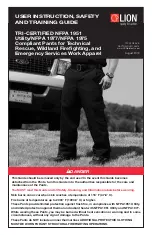
10
6.3
INSPECTION PROCESS AND CRITERIA
1.
Preparation for Inspection
A.
Place Pants on a clean surface in a brightly lighted area.
2. Inspecting the Pants
A.
Fabric: Examine for dirt, discoloration, thin spots, holes, tears,
embrittlement, cracking, burns, abrasions, and worn spots.
a. Discoloration is a sign of overexposure to light or heat.
b. Embrittlement, cracking or burns are a sign that other parts of the Pants
may be worn out or damaged and must be thoroughly inspected.
c. Grasp any part of the fabric that may be damaged or flawed in both
hands, and try to push your thumbs through the fabric.
(Fig. 2). If the fabric punctures, it must be repaired if economically
practical, or the Pants should be retired and disposed of in accordance
with Sections 14 and 15 of this Guide.
B.
Closure Systems: Examine for functionality and damage.
a. Hook and Loop – Engage and disengage hook and loop attachments
to make sure they function well. Examine for worn, abraded, curled, or
melted pieces that require replacement. Check stitching for loose thread
that would require repair.
b. Zippers – Examine all zippers for functionality and corrosion that would
require replacement. Check stitching for loose threads that would
require repair.
c. Hardware – Examine all hardware (i.e. zippers, hook and loop, and
buttons) for corrosion or other damage that would require replacement.
Check that their attachment to the Pants is secure.
C.
Reinforcements, pockets, etc.: Examine all reinforcements and components
to make sure they are securely sewn to the Pants. Check all fasteners on
pocket flaps for functionality and damage.
D. Accessories: Check all accessory items to ensure that they meet
manufacturer’s specifications.
E.
Stitching and Seams: Examine all seams for loose threads, breaks, skipped
stitches, or weaknesses.
F.
Labels
a. Verify that all Safety, Cleaning, and Information labels are on the Pants.
See p. 2 and Section 5 of this Guide.
b. Make sure that all Safety, Cleaning, and Information Labels are legible
and securely attached to the Pants.
6.4.
RECORDKEEPING
For manual records, record all inspections and your results on the Inspection,
Washing, Repair, Retirement, and Disposal Record located in the back of this Guide.
Maintain this form unless your organization has provided you with a comparable
recordkeeping method for this purpose.
Most performance properties of the Pants and its components cannot be tested by the
user in the field.
WARNING
!
FIG. 2 Test fabric
strength with thumbs
Содержание NFPA 1975
Страница 22: ...22 NOTES...
























